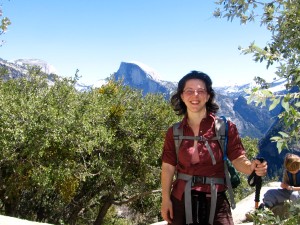
Have you ever noticed that looking at trees feels like a brain massage?
That’s the only way I know how to articulate the immediate release I feel when I’m out in nature.
It’s a total body release. First, I feel the muscles around my eyes relax. Then my forehead de-wrinkles. And finally, I feel a softening throughout the rest of my body.
Nerd that I am, I’m fascinated by scientific research that explains my own experiences. I guess I’m a sucker for external validation of my internal processes!
So I perked up today when this article about The Cognitive Benefits of Interacting with Nature popped up on twitter. Here’s the tweet that caught my attention (thanks Gretchen Rubin via Jonathan Fields):
A 45-minute walk in a park boosts cognitive performance; a walk downtown doesn’t.
Cool! I thought. I want to know more about that. So I read the article, and here’s a brief synopsis (gentle readers will, I’m sure, correct me about anything I’ve over-simplified):
Attention is placed in two different types of ways: (1) It can be “captured” by inherently interesting or important stimuli. This is known as “involuntary attention.” (2) It can be intentionally focused in a specific direction. This is known as “directed attention.”
Spending time in nature invokes a mild kind of Attention #1. The grass ripples in the wind. A hummingbird flutters. The sun glints off of the water. Our attention shifts with ease from place to place.
While the brain is in this mode, the mechanisms that control our “directed attention” (#2) get to lay low for a while. They’re on break. They get to relaaaaaax, maaaan!
When we go back to work after a nature break, we’re better able to focus because our Directed Attention has had a chance to recharge. She’s revved up and ready to go again!
Interestingly, walks in the city don’t allow our Directed Attention to take a break. Watch out for that car! Look both ways when you cross the street! Stay safe! There are too many important things to focus on.
But according to this article, even looking at a picture of nature can give our Directed Attention some time off. A simple picture! I am gonna hafta try this and see if it works.
As the authors of the study concluded, “simple and brief interactions with nature can produce marked increases in cognitive control.”
I’m committing to giving myself the gift of “simple and brief interactions with nature” on a daily basis. I bet even a couple of minutes will do the trick! Will you join me? We’ll all be smarter (and probably happier) because of it.

Interesting Post–particularly the fact that a _picture_ of nature almost has the same effect as real nature. Clearly no moving hummingbirds or animal sounds in a picture. So, is it more of a pavlovian thing? Could the image of nature trigger responses that we are conditioned to from real nature?
Cool stuff–keep posting.
g
Thanks for commenting, Gary! I don’t really understand that point myself. someone more patient (and mathematially inclined) than I could read all the statistical info in the study and tell me what the picture-thing is all about. (Anyone out there want to do that?)
BTW, for all you intrepid “Comments” readers — Gary is the director of an awesome charter school that he and I (and a big group of hardy folks) founded. http://www.wcchschool.org. Check it out!
Thank you for highlighting the study — I am off to take a look at it. Meanwhile, my thought is that it may be related to how we, as animals, respond to and interact with machines.
Gretchen,
My life’s work has been about bringing us (people) back in to relationship with Nature, with Soil, Air, Water & Fire. Unfortunately I don’t find these approaches to be one about relationship-building. It’s more about another way to — USE Nature. I fall in to the same trap a lot, and I really want to be more alert to more ways to avoid this trap; that’s why I feel free to be so blunt in my analysis. I also appreciate your wondering, adventurous energy, and I would love to talk with you more, if you want.
Dolores
Hi Dolores! How wonderful to see you on the blog. And I adore your comment! It’s an interesting distinction between USING nature and being IN RELATIONSHIP WITH nature. I’ll have to chew on this a bit. I wonder if those are mutually exclusive categories… Hmmmmm… Perhaps it’s possible to both use nature and be in relationship with it, especially if my using it does not actually do any harm? But this is theoretical speculation. I’m mostly so grateful for your reminder of a choice that is always available to me: to what extent am I open to relationship with self/others/world/nature? To what extent am I using self/others/world/nature?
“Perhaps it’s possible to both use nature and be in relationship with it…”
Is it actually possible to distinguish humanity-in-Nature from humanity “using” Nature?
Being that “using” Nature is something that humans do… how is it that what we’re doing can be considered outside of Nature?
I should make it clear I’m making a philosophical point, not a political or ecological point.
But in fact, I believe that the moment when humans fully realize that everything they do IS Nature is the moment we intuitively figure out how to live sustainably on the Earth for the long haul.
With regards to this study, it should effectively serve to highlight the the fact that our attempts to consider ourselves above or outside of the natural forces that brought us to this point clearly has measurable detrimental effects on our health and on the health of everything we touch… which these days IS everything.